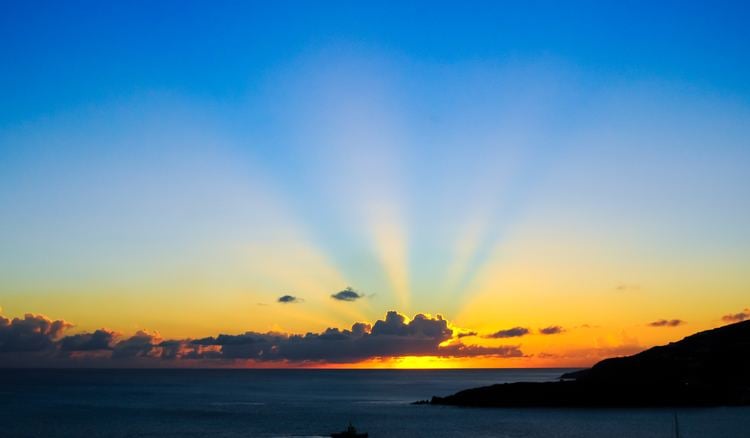 | ||
Dawn (from an Old English verb dagian "to become day") or astronomical dawn is the time that marks, depending on the specific usage, the beginning of the twilight before sunrise, the period of the pre-sunrise twilight or the time of sunrise. When identified as the beginning of or the period of twilight, it is recognized by the presence of weak sunlight, while the Sun itself is still below the horizon.
Contents
- Types of dawn
- Astronomical dawn
- Nautical dawn
- Civil dawn
- Effects of latitude
- Equator
- Polar regions
- Example
- Mythology and religion
- Literature
- References

Types of dawn

Different definitions exist for the start of dawn. The difference between these definitions is the amount of sunlight that must be present. This can be correlated with the angular distance of the centre of the Sun (degrees) below the horizon, in the morning:
Astronomical dawn
Astronomical twilight begins at the moment after which the sky is no longer completely dark after astronomical dawn. This occurs when the Sun is 18 degrees below the horizon in the morning. Though it is possible to localize the direction of the Sun during astronomical dawn and dusk, astronomical dawn and dusk are night, even without clouds. The zenith is extremely dark and more than just the brightest stars can be seen (except low above the horizon in the direction of the sun).
Nautical dawn

Nautical twilight begins at the time at which there is enough sunlight for sailors to distinguish the horizon via sea but artificial light will be needed to perform outdoor activities; formally, when the Sun is 12 degrees below the horizon in the morning. Nautical Dawn is still quite dark and is considered night.
Civil dawn
Civil twilight begins at the time at which there is enough light for most objects to be distinguishable, so that some outdoor activities but not all can commence; formally, when the Sun is 6 degrees below the horizon in the morning. At civil dawn there is some darkness and at the zenith. The sky is still a bit dark and civil dawn is still considered night.
Effects of latitude
The duration of the twilight period between first light and sunrise varies greatly depending on the observer's latitude, from a little over twenty minutes in equatorial regions, to many hours in polar regions, to several weeks at the poles.
Equator
All phases of dawn and dusk are shortest at the equator, where the Sun at equinox rises and sets at a right angle to the horizon; the steps between civil, nautical, and astronomical dawn or dusk correspond to only 24 minutes each. At all places on the earth, dawn and dusk times are fastest around the equinoxes and slowest at the summer and winter solstices.
Polar regions
As the calendar approaches the summer or winter solstice, the days or nights, respectively, get longer, which can have a potential impact on the time and duration of dawn and dusk. This effect is more pronounced closer to the poles, where the Sun rises at the spring equinox and sets at the autumn equinox, with a long period of dawn/dusk, lasting for a few weeks.
The polar circle (at 66°30′ N or S) is defined as the lowest latitude at which the Sun does not set at the summer solstice. Therefore, the angular radius of the polar circle is equal to the angle between the plane of Earth's equator and that of the ecliptic. This period of time with no sunset lengthens closer to the pole.
Near the summer solstice, latitudes higher than 54°30′ get no darker than nautical dawn/dusk; the "darkness of the night" varies greatly in these latitudes.
At latitudes higher than about 59°20, summer nights get no darker than civil dusk or dawn. This period of "bright nights" is longer at higher latitudes.
Example
Around the summer solstice for instance, Glasgow, Scotland at 55°51′ N and Copenhagen, Denmark at 55°40′ N get a few hours of "night feeling", Oslo, Norway at 59°56′ N and Stockholm, Sweden at 59°19′ N seem very bright all the time the Sun is below the horizon. When the sun gets 9.0 to 9.5 degrees below the horizon (at summer solstice this is at latitudes 57°30′–57°00′), the zenith gets dark even on cloud-free nights (if there is no full moon); more than just the brightest stars are clearly visible in a large majority of the sky.
Mythology and religion
Many Indo-European mythologies have a dawn goddess, separate from the male Solar deity, her name deriving from PIE *h2ausos-, derivations of which include Greek Eos, Roman Aurora and Indian Ushas. Also related is Lithuanian Aušrinė, and possibly a Germanic *Austrōn- (whence the term Easter). In Sioux mythology, Anpao is an entity with two faces.
The Hindu dawn deity Ushas is female, whereas Surya, the Sun, and Aruṇa, the Sun's charioteer, are male. Ushas is one of the most prominent Rigvedic deities. The time of dawn is also referred to as the Brahmamuhurtham (Brahma is god of creation and muhurtham is a Hindu unit of time), and is considered an ideal time to perform spiritual activities, including meditation and yoga. In some parts of India, both Usha and Pratyusha (dusk) are worshiped along with the Sun during the festival of Chhath.
Prime is the fixed time of prayer of the traditional Divine Office (Canonical Hours) in Christian liturgy, said at the first hour of daylight.
In Islam, astronomical dawn (Arabic fajr) is the time of the first prayer of the day, and the beginning of the daily fast during Ramadan.
In Judaism, the question of how to calculate dawn (Hebrew Alos/Alot HaShachar, or Alos/Alot) is posed by the Talmud, as it is has many ramifications for Jewish law (such as the possible start time for certain daytime commandments, like prayer). The simple reading of the Talmud is that dawn takes place 72 minutes before sunrise. Others, including the Vilna Gaon, have the understanding that the Talmud's timeframe for dawn was referring specifically to an equinox day in Mesopotamia, and is therefore teaching that dawn should be calculated daily as commencing when the sun is 16.1 degrees below the horizon. The longstanding practice among most Sephardic Jews is to follow the first opinion, while many Ashkenazi Jews follow the latter view.
